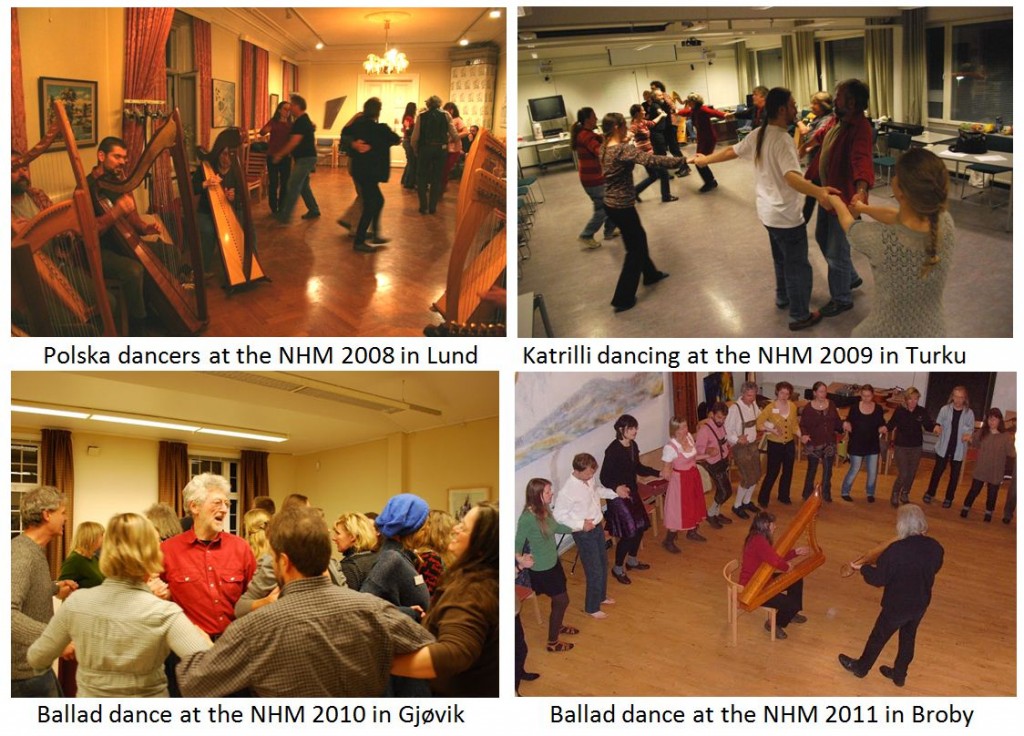(på svenska)
Instruments called “harps” are mentioned in numerous sources in all Nordic countries: In sagas, folk ballads, poems and historiography. Of course, one has to be aware that these mentionings don’t necessarily denote the same objects: The term “harp” has been (and still is) used in a very broad sense in the Scandinavian languages, for many different stringed instruments: various psalteries (including the Finnish kantele, called harpa in the Swedish Finnskogen), plucked or strummed lyres (which is probably what is referred to as harpe in the Norse sagas), bowed lyres (stråkharpa), langeleik (långharpa), hammered dulcimer (hammarharpa), keyed fiddle (nyckelharpa), hurdy-gurdy (hjulharpa), jaw harp (munnharpe) and more.
Nevertheless, there is also evidence for the existence of harps in musicological sense (i.e. chordophones with the plane of strings perpendicular to the resonator) in preserved museum specimens – the earliest specimen from Norway is dated to 1681.
Numerous harps sensu stricto are also featured in medieval iconography on stone reliefs, church paintings and wood carvings in Denmark, Norway and Sweden.
From Denmark, historical documents tell about court harpists (Edvard Adam, Magnus Maxi, Darby Scott and Carolus Oralii) at the court of Christian IV, one of which is depicted in the painting by Rainhold Timm (ca 1622, now at the Danish Music Museum in Copenhagen). Numerous Danish town musicians of the 17th and 18th century are known to have played a “David’s harp”, and the Music History Museum in Copenhagen stores several small diatonic harps (called “amateur harps”) from the 18th to 19th centuries, some of which were produced by Danish instrument makers.
Also from Finland, we know about harpists in court music, entertainment music and street music: “Mikael harpolekare” played court music in Turku Castle, 1580.
Many years later, the blind girl Charlotta Seuerling (who was living in Turku about 1810)
played a small pedal harp to accompany her melancholic Swedish songs. Henryk Sulkawa from Virrat (Western Finland) built a small diatonic harp in 1818, which is quite similar to the harp of Kalvsvik (Småland in Sweden). Even Kreeta Haapasalo, the most famous Finnish kantele player of the 19th century, was inspired by Central-European wandering harpers touring the Nordic countries and playing on markets, in streets and taverns.
In Sweden, there are several harps in strict sense produced by various Swedish instrument makers, among them Mattias Petter Kraft in Stockholm (who also made Bellman’s cister in 1781). Perhaps the harp of Mollberg (“pling plingeli plång“) mentioned in the poem Fredmans Epistel 45 can be imagined as the harps that Bellman’s instrument maker produced in 1780 and 1785. Both are stored at the repository of the Swedish Museum of Performing Arts in Stockholm.
Nowadays, several harpists and harpers live in Nordic countries, play different kinds of harps, and different kinds of music, without necessarily being aware of each other’s existence: One lives in Copenhagen, the other one in Helsinki, another in Oslo, another in Stockholm, yet another in Senja… And many other musicians in the North play plucked instruments related to the harp – such as kantele, langeleik, lyre, and more – and most of their tunes can without much effort be transferred to the harp, and vice versa.
The time has come to meet and to play music together!

